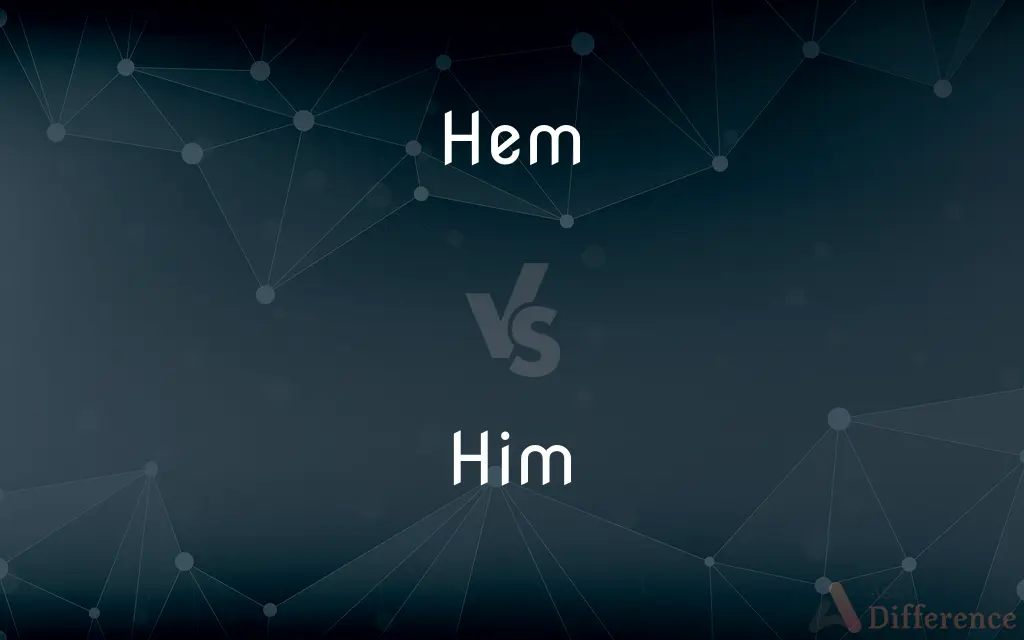Hem vs. Him — What's the Difference?
By Maham Liaqat & Urooj Arif — Updated on March 28, 2024
"Hem" refers to the edge of cloth or clothing that has been turned under and sewn, while "him" is a pronoun used to refer to a male person or animal previously mentioned or easily identified.

Difference Between Hem and Him
Table of Contents
ADVERTISEMENT
Key Differences
"Hem" is a term used in sewing and fashion design to describe the finished edge of a piece of cloth or garment. This finishing process involves folding the edge of the fabric and sewing it to prevent fraying and to give the garment a clean, polished appearance. On the other hand, "him" is a pronoun in the English language, specifically a masculine object pronoun. It is used in sentences to refer to a male subject that has been previously mentioned or is already known to the listener or reader.
While "hem" is associated with the physical and tangible aspects of clothing and textiles, "him" deals with language and communication, specifically in the context of referring to individuals. The use of "hem" is crucial in the creation and maintenance of clothing, affecting its durability and aesthetic appeal. Conversely, "him" plays a vital role in English grammar and syntax, facilitating clear and effective communication about male subjects.
In terms of application, "hemming" is a skill learned by tailors, seamstresses, and anyone involved in garment making or alteration. This skill can significantly impact the functionality and style of clothing. "Him," however, is fundamental to English language proficiency, used by speakers and writers to construct sentences that accurately convey thoughts, actions, and narratives involving male entities.
Understanding the distinction between "hem" and "him" is essential not just for linguistic clarity but also for cultural and social contexts. The proper use of "hem" can denote attention to detail and craftsmanship in textiles, while correctly using "him" respects grammatical norms and enhances communication effectiveness. Despite their pronounced differences, both terms highlight the importance of precision, whether in the creation of garments or the construction of sentences.
Comparison Chart
Definition
Finished edge of cloth
Masculine object pronoun
ADVERTISEMENT
Usage
Sewing and fashion
English grammar and syntax
Role
Prevents fraying, adds aesthetic value
Refers to a male individual
Importance
Affects garment durability and style
Facilitates clear communication
Skill Required
Tailoring, sewing
Language proficiency
Compare with Definitions
Hem
Folded and sewn edge of fabric.
The hem of his jeans was coming undone.
Him
Pronoun referring to a male.
I asked him if he wanted tea.
Hem
Finished edge on clothing.
She sewed a lace trim along the hem of her dress.
Him
Used to denote a male person or animal.
The dog chased the ball, and I called him back.
Hem
Can be decorative or functional.
The skirt featured a decorative hem with embroidered flowers.
Him
Object pronoun in sentences.
She gave him the book yesterday.
Hem
Prevents fabric from fraying.
A tight hem ensures the fabric edges remain neat.
Him
Essential for clear communication.
Without him, the project would not have been completed.
Hem
Tailoring term for edge-finishing.
Hemming the curtains to the right length took an afternoon.
Him
Integral part of English grammar.
The teacher explained how to correctly use 'him' in a sentence.
Hem
A hem in sewing is a garment finishing method, where the edge of a piece of cloth is folded and sewn to prevent unravelling of the fabric and to adjust the length of the piece in garments, such as at the end of the sleeve or the bottom of the garment.
Him
A male
The dog is a him.
Hem
An edge or border on a piece of cloth, especially a finished edge, as for a garment or curtain, made by folding an edge under and stitching it down.
Him
A masculine pronoun; he as a grammatical object.
Hem
The height or level of the bottom edge of a skirt, dress, or coat; a hemline.
Him
With dative effect or as an indirect object.
Hem
A short cough or clearing of the throat made especially to gain attention, warn another, hide embarrassment, or fill a pause in speech.
Him
Following a preposition.
Hem
To fold back and stitch down the edge of.
Him
With accusative effect or as a direct object.
Hem
To surround and shut in; enclose
A valley hemmed in by mountains.
Him
Used reflexively: (to) himself.
Hem
To utter a hem.
Him
With nominative effect: he, especially as a predicate after be, or following a preposition.
Hem
To hesitate in speech.
Him
Alternative case form of Him
Hem
Used to fill in the gap of a pause with a vocalized sound.
Him
(informal) A male person or animal.
I think this bird is a him, but it may be a her.
Hem
An utterance or sound of the voice like "hem", often indicative of hesitation or doubt, sometimes used to call attention.
Him
Them. See Hem.
Hem
(sewing) The border of an article of clothing doubled back and stitched together to finish the edge and prevent it from fraying.
Him
The objective case of he. See He.
Him that is weak in the faith receive.
Friends who have given him the most sympathy.
I never saw but Humphrey, duke of Gloster,Did bear him like a noble gentleman.
Hem
A rim or margin of something.
Hem
In sheet metal design, a rim or edge folded back on itself to create a smooth edge and to increase strength or rigidity.
Hem
To make the sound expressed by the word hem; to hesitate in speaking.
Hem
To make a hem.
Hem
(transitive) To put hem on an article of clothing, to edge or put a border on something.
Hem
(transitive) To shut in, enclose, confine; to surround something or someone in a confining way.
A small yard hemmed about by a tall hedge.
Hem
Obsolete form of 'em
Hem
Them
Hem
An onomatopoetic word used as an expression of hesitation, doubt, etc. It is often a sort of voluntary half cough, loud or subdued, and would perhaps be better expressed by hm.
Cough or cry hem, if anybody come.
Hem
An utterance or sound of the voice, hem or hm, often indicative of hesitation or doubt, sometimes used to call attention.
Hem
The edge or border of a garment or cloth, doubled over and sewed, to strengthen it and prevent raveling.
Hem
Border; edge; margin.
Hem
A border made on sheet-metal ware by doubling over the edge of the sheet, to stiffen it and remove the sharp edge.
Hem
To make the sound expressed by the word hem; hence, to hesitate in speaking.
Hem
To form a hem or border to; to fold and sew down the edge of.
Hem
To border; to edge
All the skirt aboutWas hemmed with golden fringe.
Hem
Lap that forms a cloth border doubled back and stitched down
Hem
Fold over and sew together to provide with a hem;
Hem my skirt
Hem
Utter `hem' or `ahem'
Common Curiosities
What is a hem?
A hem is the sewn edge of a piece of clothing or fabric, created by folding the edge over and sewing it down to prevent fraying.
What's the importance of a hem?
Hems are important for preventing the fabric from fraying, adding to the garment's durability, and providing a finished look.
How can one learn to hem clothing?
Learning to hem clothing can be achieved through sewing tutorials, classes, or guides, starting with basic techniques and progressing to more advanced methods.
How is 'him' taught in language learning?
"Him" is taught as part of English grammar, focusing on its role as an object pronoun and its proper use in sentences involving male individuals or animals.
Why is it important to use 'him' correctly?
Using "him" correctly is crucial for clear and grammatically accurate communication in English, especially when referring to male subjects.
Who uses the word 'hem'?
The term "hem" is used by tailors, seamstresses, fashion designers, and anyone involved in sewing or garment making.
How do you use 'him' in a sentence?
"Him" is used as an object pronoun to refer to a male person or animal, e.g., "I gave him the message."
Is 'him' used differently in other languages?
In languages other than English, pronouns that serve the same purpose as "him" may have different forms based on grammatical gender, case, or number.
In gender-neutral language, what alternatives are used instead of 'him'?
In gender-neutral language, "them" or "their" can be used as alternatives to "him" when the gender of the person is not specified or when referring to someone who prefers gender-neutral pronouns.
How does the use of 'him' change in different English dialects?
The use of "him" remains consistent across different English dialects, but variations in pronunciation or colloquial usage may occur.
What are common mistakes made when using 'him'?
Common mistakes include confusing "him" with "he" (subject pronoun) or using "him" when a gender-neutral pronoun would be more appropriate.
Why is it important to understand pronouns like 'him' in learning English?
Understanding pronouns like "him" is crucial for mastering English grammar, ensuring clarity in communication, and respecting personal pronoun preferences.
Can 'him' be used to refer to non-human subjects?
Yes, "him" can be used to refer to male animals or pets, but it is not typically used for inanimate objects or abstract concepts.
Can 'hem' have other meanings?
Yes, "hem" can also refer to the sound of hesitation in speech, similar to "um" or "uh," though this is less common compared to its sewing-related meaning.
What tools are needed to create a hem?
To create a hem, you typically need a needle, thread, scissors, measuring tape, and sometimes a sewing machine for more efficiency.
Can hems be altered after they're made?
Yes, hems can be altered or adjusted after they're made, either by hand or with a sewing machine, to change the length of a garment.
Do all garments have hems?
Most garments have hems to ensure a clean finish and prevent the fabric from fraying, but some items may have raw or intentionally unfinished edges for style.
Share Your Discovery

Previous Comparison
Goosefish vs. Monkfish
Next Comparison
Gust vs. SquallAuthor Spotlight
Written by
Maham LiaqatCo-written by
Urooj ArifUrooj is a skilled content writer at Ask Difference, known for her exceptional ability to simplify complex topics into engaging and informative content. With a passion for research and a flair for clear, concise writing, she consistently delivers articles that resonate with our diverse audience.
















































